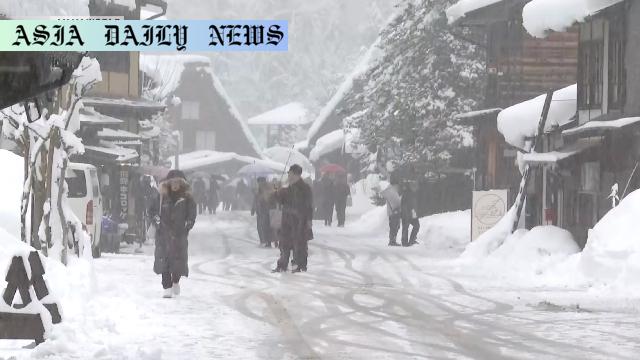Snowfall triggers warnings of traffic disruptions and avalanche risks in Japan.

Introduction to the Record-Breaking Snowfall
The strongest cold wave of the season has brought unprecedented snowfall to Japan, recording historic levels along the Sea of Japan and the Pacific coasts. The snowfall, which began intensifying from February 3, disrupted daily life across urban centers like Kyoto and Nagoya, while areas like Hokkaido experienced snowfall levels unmatched in weather history. This unusual weather pattern has caused widespread concern due to its impact on infrastructure and personal safety.
Unprecedented Snowfall Records
One of the most remarkable statistics emerged from Obihiro City in Hokkaido, where 120 centimeters of snow accumulated within 12 hours — a national record. Similarly, Shirakawa village in Gifu Prefecture reported 129 centimeters of snow over a 48-hour period, the highest recorded since 1983. Niigata City also witnessed record-breaking snowfall, with 44 centimeters amassing over just 6 hours, evidencing the extreme severity of this weather event.
Implications for Daily Life and Infrastructure
These extraordinary weather conditions have exacted a significant toll on daily life. Urban centers unaccustomed to heavy snowfall, such as Kyoto and Nagoya, struggled to maintain normal activities. Kyushu Island, known for its milder climate, saw snow pile up even in flat areas, further underlining the rarity of this extreme weather event. Reports of traffic disruptions, power outages, toppled trees, and heightened avalanche risks have become widespread, emphasizing the challenges posed by this cold wave.
Precautions for Snow Clearing
In light of these heavy snowfalls, the Japan Meteorological Agency has issued specific safety protocols for snow clearing. Residents are urged to exercise precaution when clearing rooftops, recommending the use of safety gear such as helmets and ropes. Teamwork is advised, avoiding solo activities that could lead to accidents. Proper ladder stabilization is emphasized to minimize risks during snow management in such extreme conditions.
Weather Outlook
The cold air mass is not expected to dissipate rapidly, with intermittent snowfall predicted along the Sea of Japan coast through Tuesday. This forecast has prompted weather officials to extend warnings about continued disruptions and possible dangers. With snow accumulation exceeding seasonal averages in many regions, vigilance remains key to ensuring public safety.
Conclusion
Japan’s record-breaking snowfall serves as a stark reminder of the increasing unpredictability of weather patterns. It also highlights the importance of preparedness in mitigating the impacts of such severe weather. Authorities are working tirelessly to address the challenges posed by the heavy snow, urging citizens to stay informed and cautious during this unprecedented cold wave.
Commentary
Historic Snowfall: A Rare Sight in Japan
The recent record-breaking snowfall in Japan has captivated attention not only because of its intensity but also due to its wide-reaching impact. It’s fascinating to note how regions such as Kyoto and Kyushu, which rarely see much snow, have experienced significantly altered landscapes in a matter of days.
A Stark Reminder of Nature’s Power
Such weather phenomena underline the unpredictability of nature and highlight the broader implications of climate variations. The combination of heavy snowfall and the challenges it brings to urban life serves as a wake-up call regarding our vulnerability to extreme weather. Seeing areas like Obihiro in Hokkaido record a national milestone of snow accumulation is both awe-inspiring and concerning.
The Role of Preparedness
While the snowfall’s beauty is captivating, its dangers cannot be underestimated. The advice given by weather officials, such as taking safety measures when clearing snow from rooftops, is critical. This guidance speaks to the importance of broader public awareness campaigns to educate citizens about remaining cautious during extreme weather events.
Reflection on Future Implications
One can’t help but wonder whether such aberrant weather patterns are indicative of larger changes in global climate. As heavy snowfall disrupts energy distribution and transportation, questions arise about how infrastructure can evolve to better resist such occurrences. Preparing for these types of events will be critical for regions worldwide, not just Japan. This exceptional snowfall offers lessons in community resilience and adaptability worth considering globally.


